This article will go over the average and median fuel economies for compact/sub-compact crossovers as well as what is considered good, bad, and normal gas mileage depending on the type of crossover.
The figures used in this article are for the 2022-2023 model years.
See our equivalent article about larger SUVs here.
What is the fuel economy of Crossover SUVs?
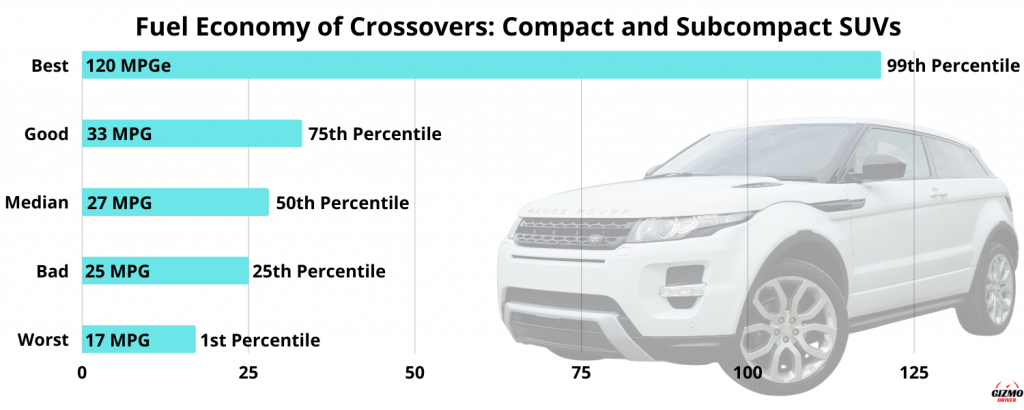
The average combined fuel economy of crossovers is 32.8 miles per gallon (MPG), with a median of 27 MPG. The typical crossover gets 13% more miles per gallon than the average vehicle, which gets 29.1 MPG. The median crossover gets 4 more miles per gallon than the median car.
The average is skewed by a substantial MPG(e) difference between electric and gas-powered crossovers. Around 70% of crossovers get less gas mileage than the average of 32.8 MPG.
When both gas and electricity are taken into consideration, the median fuel economy, which is 27 miles per gallon, is a considerably better indicator of efficiency.
What is a good fuel economy for a crossover?
Any crossover that gets 33 MPG or more gets good gas mileage. This is the 75th percentile, which means that 75% perform worse. For a crossover, a normal or acceptable MPG range is 32–25 MPG (75th–25th percentiles).
A bad MPG for a crossover would be less than 24 MPG.
| Percentile | Car | MPG |
| 99th | Hyundai Kona Electric | 120 |
| 75th | Nissan Rogue FWD 1.5L 3 cyl | 33 |
| Median (50th) | Volkswagen Taos 4motion 1.5L 4 cyl | 28 |
| 25th | Mazda CX-5 4WD 2.5L 4 cyl | 24 |
| 1st | BMW X4 M Competition 3.0L 6 cyl | 17 |
Fuel cost of crossovers
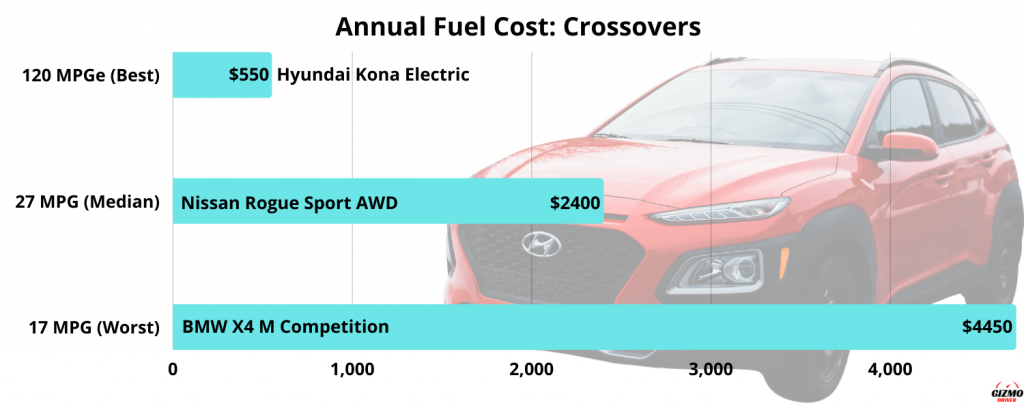
Depending on the cost of fuel, a crossover’s average fuel cost ranges from $1800 to $3000. On the extremes, crossovers can range in price from $4450 to $550 per year in terms of annual fuel costs.
The median crossover is 16% less expensive on fuel than the average car, but 4% more expensive than the average sedan.

As illustrated in this graph, the gasoline cost to fuel economy ratio is not linear. The most dramatic changes in fuel costs occur in the lowest MPG ranges.
As you approach the MPG ranges where plug-in hybrids and electric vehicles run, the cost reductions become less substantial.
These are fairly broad estimates that don’t account for a variety of parameters such as engine size, powertrain, or vehicle weight.
The rest of this article will go over more detailed fuel economy data for several of the numerous categories in which a compact or subcompact SUV might be classified.
Fuel Economy by Crossover Size – Compact and Subcompact SUVs
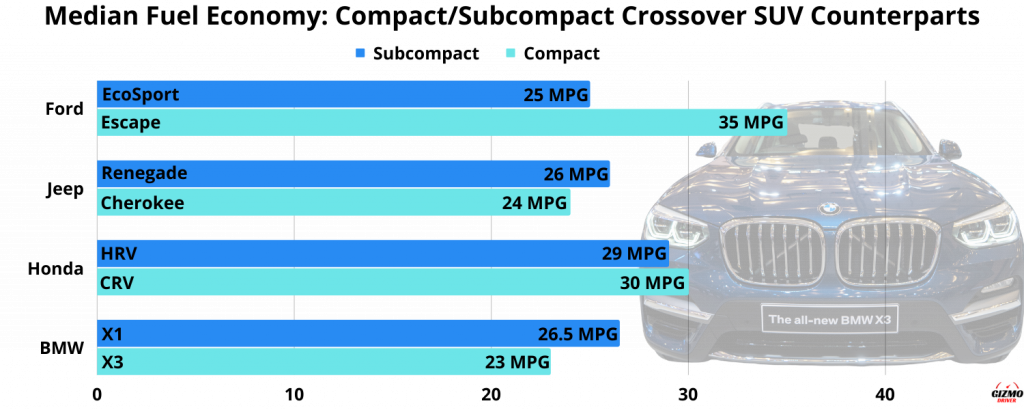
What is the fuel economy of crossovers (compact SUVs)
A compact crossover’s average fuel economy is 29.8 MPG. The average is 25 miles per gallon. Compact crossovers use 2% less gasoline than the average car.
Good fuel economy for a crossover:
Anything above 33 MPG, which is the 75th percentile, is considered good fuel economy for a compact SUV. A typical compact crossover’s gas mileage is usually 32 and 24 miles per gallon.
A poor fuel economy falls inside the 25th percentile or less than 23 miles per gallon.
Most-median-least fuel-efficient crossovers:
| Percentile | Car | MPG |
| 99th | Volkswagen ID.4 Pro | 112 |
| 75th | Nissan Rogue FWD 1.5L 3 cyl | 33 |
| Median (50th) | Lexus NX 350 AWD 2.4L 4 cyl | 25 |
| 25th | Jaguar E-Pace 2.0L 4 cyl | 23 |
| 1st | BMW X3 M Competition 3.0L 6 cyl | 17 |
What is the fuel economy of subcompact SUVs
The average and median fuel economy of subcompact SUVs are 37.5 and 30 miles per gallon, respectively. This is significantly better than compact crossovers, which get 4.5 MPG less on average.
Subcompact crossover SUVs are among the most fuel-efficient vehicles on the road. They do, however, fall short when compared to compact sedans, which get 2 miles per gallon higher on average.
Good fuel economy for a subcompact SUV:
A good fuel economy for a subcompact crossover is 33 MPG or more, while anything less than 27 MPG is considered low. These are the 75th and 25th percentile statistics for sub-compact crossovers. A fuel economy from 28 to 32 miles per gallon is within the acceptable range.
Most-median-least fuel-efficient subcompacts SUVs:
| Percentile | Car | MPG |
| 99th | Hyundai Kona Electric | 120 |
| 75th | Nissan Kicks 1.6L 4 cyl | 33 |
| Median (50th) | Chevrolet Trailblazer FWD 1.2L 3 cyl | 30 |
| 25th | Kia Seltos AWD 1.6L 4 cyl | 27 |
| 1st | Hyundai Kona N 2.0L 4 cyl | 23 |
Fuel economy of Luxury Crossovers
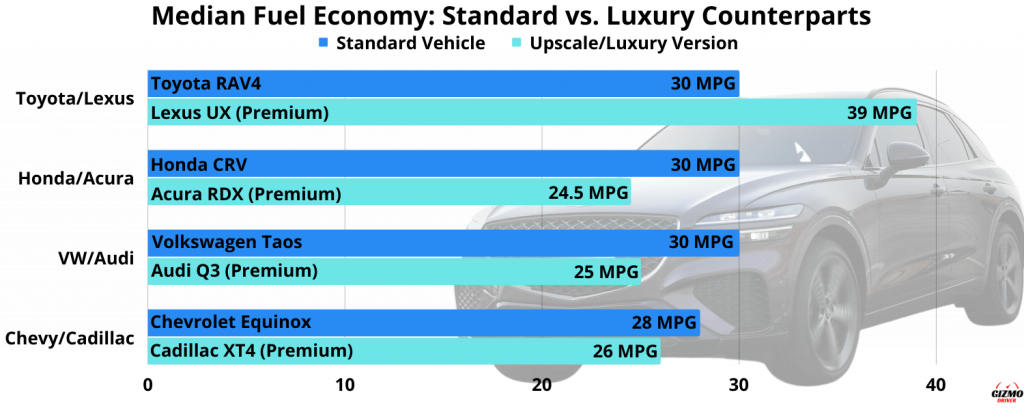
The average fuel economy of luxury crossovers is 30.1 miles per gallon, with a median of 24 miles per gallon. The average luxury crossover gets 1 more mile per gallon than the average car. This is also true for the median.
Luxury crossovers vs. standard crossovers – fuel economy difference
A normal non-luxury crossover’s average fuel efficiency is 36.1 MPG, with a median of 30 MPG. The average and median premium crossovers both get 6 MPG less than a standard crossover.
Aside from Toyota and Lexus, a similar story can be seen in terms of premium and non-luxury crossovers that share the same platform. Luxury crossovers have a fuel economy averaging 3-6 MPG less than their basic crossover counterparts.
Larger engines, wheels, premium equipment, and more technology are common aspects of luxury vehicles, which, consequently, raise the vehicle’s weight.
Good fuel economy for a luxury crossover:
For a luxury crossover, good gas mileage is 27 MPG or above, which puts it in the upper percentile (75th) of luxury crossovers. Anything between 23 and 27 mpg is deemed acceptable. Under 23 MPG, which is the 25th percentile, is considered poor fuel efficiency.
Most-median-least fuel-efficient luxury crossovers:
| Percentile | Car | MPG |
| 99th | Audi Q4 e-tron Sportback quattro | 95 |
| 75th | Mercedes-Benz GLB250 2.0L 4 cyl | 27 |
| Median (50th) | Volvo XC60 B6 AWD 2.0L 4 cyl | 24 |
| 25th | Acura RDX AWD A-SPEC 2.0L 4 cyl | 23 |
| 1st | BMW X4 M Competition 3.0L 6 cyl | 17 |
Fuel Economy by Powertrain Type – Crossover SUVs
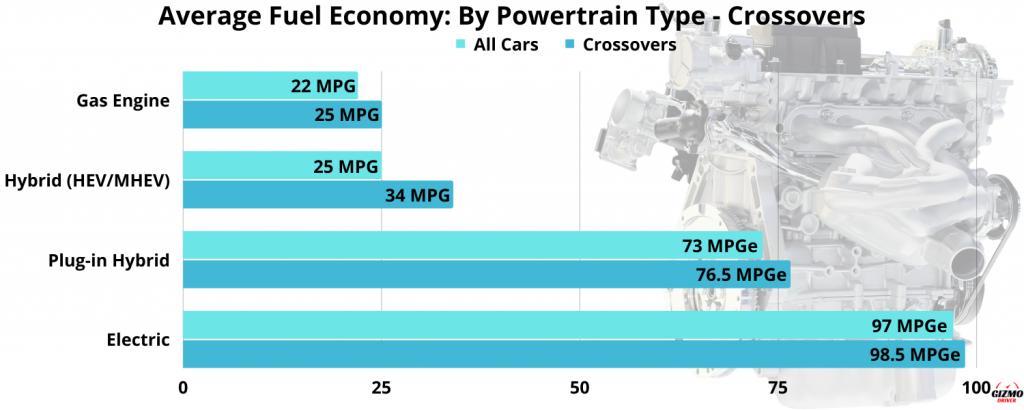
A crossover’s fuel efficiency is mostly determined by its powertrain. A plug-in hybrid automobile can be up to three times more fuel-efficient than a traditional gasoline vehicle, while electric vehicles can be up to four times more efficient!
How engine size and power affect fuel efficiency in crossovers
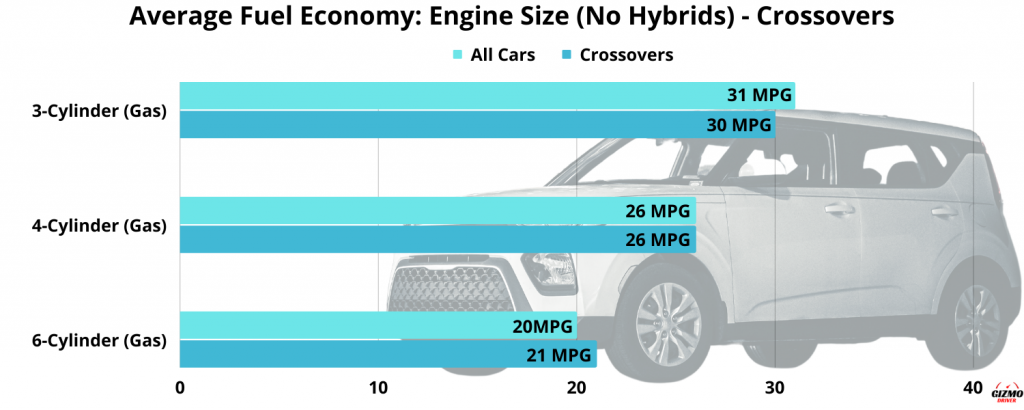
The engine size has a considerable influence on fuel economy. As shown in the table above, a conventional gasoline engine crossover’s fuel efficiency declines by 4-5 MPG for every two-cylinder increase.
How turbos affect the fuel economy on a crossover
Turbocharging does not directly reduce gas consumption, but it does allow your engine to produce greater power without consuming more gas. Turbos, in turn, save gasoline indirectly by allowing the engine to produce the same amount of power while using less fuel.
As a result, manufacturers can fit smaller, more fuel-efficient turbocharged engines into vehicles that would normally require a larger engine to provide the same level of power as a naturally aspirated engine.
The 2022 Nissan Rogue, for example, is larger and heavier than the 2022 Nissan Rogue Sport, but it gets superior gas mileage, at 33 MPG vs 28 MPG. It also has a smaller engine but produces more horsepower than the Rogue Sport. The reason behind this is that the Rogue’s 3.0L 3-cylinder engine is turbocharged.
3-cylinder gas crossovers
3-cylinder gas crossovers are among the most fuel-efficient gas vehicles available today, with an average fuel efficiency of 30.1 miles per gallon and a median of 30. The average 3-cylinder crossover consumes 43% less fuel than its 6-cylinder counterparts.
A 3-cylinder crossover should get between 31 and 28 miles per gallon, with anything less than 28 MPG being considered poor fuel efficiency for the segment.
The Nissan Rogue is the most fuel-efficient non-hybrid 3-cylinder gas crossover SUV, at 33 MPG.
| Percentile | Car | MPG |
| 99th | Nissan Rogue FWD 1.5L 3 cyl | 33 |
| 75th | Chevrolet Trailblazer FWD 1.3L 3 cyl | 31 |
| Median (50th) | Ford Escape FWD 1.5L 3 cyl | 30 |
| 25th | Ford Escape AWD 1.5L 3 cyl | 28 |
| 1st | Buick Encore GX AWD 1.3L 3 cyl | 27 |
4-cylinder gas crossovers
A 4-cylinder crossover’s average fuel efficiency is 26.3 MPG, with a median of 26 MPG. The average 4-cylinder crossover gets about the same amount of gas mileage as a 4-cylinder car.
Anything above 28 MPG, or the 75th percentile, is considered good fuel economy for 4-cylinder crossovers. Reasonable gas mileage is between 28 and 24 miles per gallon, whereas a bad one is less than the 25th percentile, or less than 24 miles per gallon.
The Nissan Kicks boasts the best MPG of any conventional gasoline crossover with a 4-cylinder engine, at 33 miles per gallon. Any four-cylinder crossover with a better fuel economy than that is a hybrid (HEV).
| Percentile | Car | MPG |
| 99th | Nissan Kicks 1.6L 4 cyl | 33 |
| 75th | Honda HR-V AWD 1.8L 4 cyl | 28 |
| Median (50th) | GMC Terrain AWD 1.5L 4 cyl | 26 |
| 25th | Acura RDX FWD 2.0L 4 cyl | 24 |
| 1st | Kia Sportage AWD 2.0L 4 cyl | 21 |
6-cylinder gas crossovers
The average fuel economy of a crossover with a 6-cylinder engine is 20 miles per gallon, with a median of 21 MPG. The typical MPG for this type of crossover is between 21 and 19 miles per gallon. Anything above the median MPG is considered good fuel economy.
Anything below the 25th percentile, which is 19 MPG, is considered a poor MPG.
The Jeep Cherokee 3.2L is the most fuel-efficient 6-cylinder gasoline crossover on the market. It gets a combined mileage of 23 miles per gallon.
| Percentile | Car | MPG |
| 99th | Jeep Cherokee FWD 3.2L 6 cyl | 23 |
| 75th | Chevrolet Blazer AWD 3.6L 6 cyl | 21 |
| Median (50th) | Genesis GV70 AWD 3.5L 6 cyl | 21 |
| 25th | Porsche Macan S 2.9L 6 cyl | 19 |
| 1st | BMW X4 M Competition 3.0L 6 cyl | 17 |
MPG difference between 4-cylinder and 6-cylinder engines in Crossovers
4-cylinder crossovers get 6.3 more miles per gallon than 6-cylinder crossovers on average.
As vehicles get smaller, their capacity to take advantage of the superior fuel economy of smaller engines grows. This is why the difference between a 4-cylinder and a 6-cylinder engine is more noticeable in smaller sedans, but less so in larger SUVs and pickup trucks.
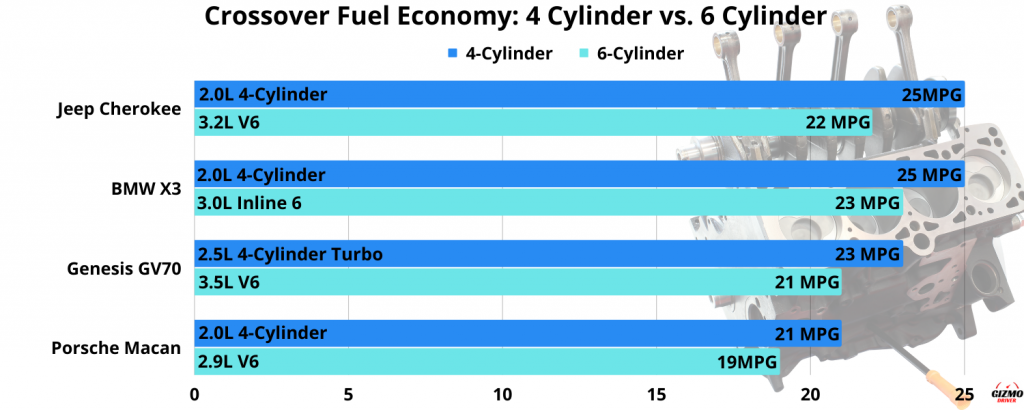
When comparing the fuel economy of the identical crossovers with 4- and 6-cylinder trims, we can see that the difference is often between 2 and 3 miles per gallon, with 4 cylinders being the better of the two.
V8 gas crossovers
There are no compact or subcompact SUVs with V8 engines as of 2022-2023.
How drivetrain affects gas mileage – RWD vs. FWD vs. AWD/4WD in crossovers
Front-wheel drive is more fuel-efficient than rear-wheel drive in most cases. The median fuel economy of a rear-wheel-drive vehicle is 20 miles per gallon, while the median fuel economy of a front-wheel-drive vehicle is 30 miles per gallon.
However, this substantial discrepancy is because most performance cars are rear-wheel drive, which makes them seem significantly less fuel-efficient.
A front-wheel or rear-wheel car’s fuel economy is often reduced by 3% to 10%, or 1-2 MPG for a petrol car when equipped with all-wheel drive or 4-wheel drive. In electric vehicles, the disparity is considerably greater.
The Efficiency of Hybrid and Electric Powered Crossover
Mild hybrid (MHEV) Crossovers
Crossovers with mild hybrid systems get an average of 23.4 miles per gallon, with a median of 23 miles per gallon. This may seem like a very low figure, however, most MHEV crossovers are fitted with larger engines that would’ve otherwise have had a substantially lower fuel efficiency.
MHEV crossovers (of which there aren’t many) get between 22 and 25 MPG. Anything above 25 MPG is considered excellent fuel economy for an MHEV crossover and falls into the 75th percentile. Anything less than 23 MPG is regarded as inefficient.
The Audi Q5 Sportback S, which gets 25 MPG and has a 2.0L four-cylinder engine, is the most fuel-efficient MHEV crossover.
| Percentile | Car | MPG |
| 99th | Audi Q5 Sportback S line quattro 2.0L 4 cyl | 25 |
| 75th | BMW X3 M40i 3.0L 6 cyl | 23 |
| Median (50th) | Land Rover Range Rover Evoque MHEV 2.0L 4 cyl | 23 |
| 25th | BMW X4 M40i 3.0L 6 cyl | 23 |
| 1st | Jaguar F-Pace P400 MHEV 3.0L 6 cyl | 22 |
Hybrid crossovers SUVs (HEV)
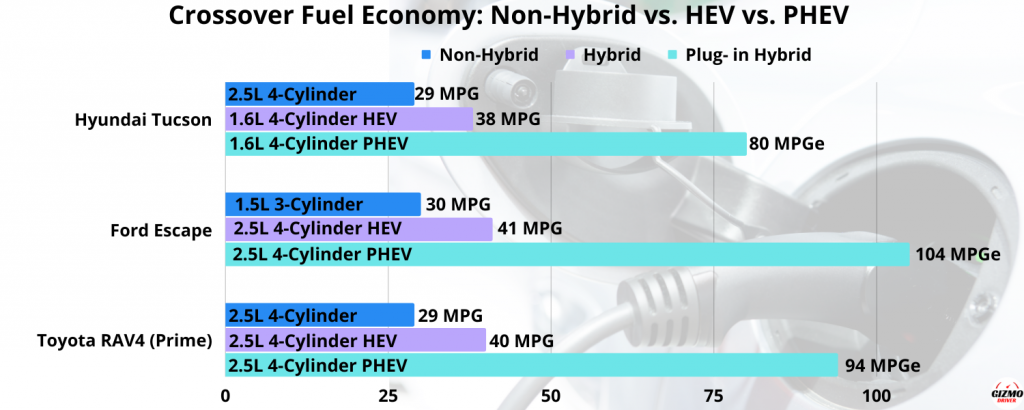
The average full hybrid crossover (compact or subcompact) gets 41.5 miles per gallon, while the median gets 40 miles per gallon. This vehicle is 31% more fuel-efficient than the average SUV hybrid, but only 85% as efficient as a hybrid sedan.
A hybrid crossover with a fuel economy of 42 MPG or greater is regarded as good, while anything between 42 and 38 MPG is rated average. Anything less than 38 MPG is considered poor fuel economy.
The Kia Niro FE, a subcompact SUV, is the most fuel-efficient hybrid crossover. It has a gas mileage of 50 miles per gallon.
| Percentile | Car | MPG |
| 99th | Kia Niro FE 1.6L 4 cyl | 50 |
| 75th | Lexus UX 250h 2.0L 4 cyl | 42 |
| Median (50th) | Toyota RAV4 Hybrid AWD 2.5L 4 cyl | 40 |
| 25th | Honda CR-V Hybrid AWD 2.0L 4 cyl | 38 |
| 1st | Hyundai Tucson Hybrid 1.6L 4 cyl | 37 |
Plug-in hybrid crossovers SUVs
The average and median fuel economy of plug-in hybrid crossovers are 76.8 and 78 miles per gallon, respectively. Normal gas mileage is between 84 and 63 miles per gallon.
85+ MPG is considered good for a PHEV crossover, while anything less than 62 MPG is considered poor.
The Ford Escape PHEV is the most fuel-efficient plug-in hybrid crossover SUV, with a fuel economy of 105 MPGe.
| Percentile | Car | MPG |
| 99th | Ford Escape FWD PHEV 2.5L 4 cyl | 105 |
| 75th | Lexus NX 450h Plus AWD 2.5L 4 cyl | 84 |
| Median (50th) | Lincoln Corsair AWD PHEV 2.5L 4 cyl | 78 |
| 25th | Volvo XC60 T8 AWD Recharge ext. Range 2.0L 4 cyl | 63 |
| 1st | Volvo XC60 T8 AWD Recharge 2.0L 4 cyl | 57 |
The efficiency of EV crossovers
A fully electric crossover’s average efficiency is 98.6 MPGe, or 34 kWh/100mi, while the median is 97 MPGe, or 35 kWh/100mi.
Most EV crossovers have an efficiency of between 91 MPGe and 105 MPGe, or 36 kWh/100mi and 32 kWh/100mi. Anything over that range is excellent, while anything below is not good with respect to EV crossovers.
The Hyundai Kona Electric is the most fuel-efficient electric crossover, with 120 MPGe, or 28 kWh/100mi.
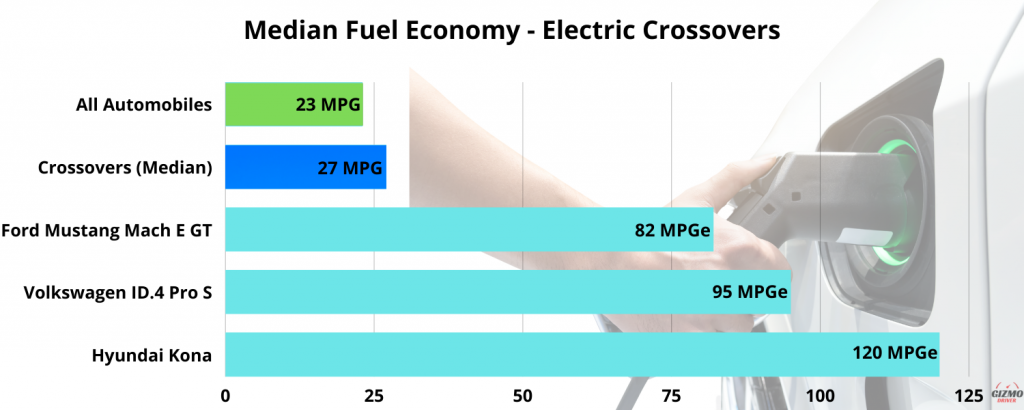
| Percentile | Car | MPG |
| 99th | Hyundai Kona Electric | 120 |
| 75th | Kia EV6 AWD Long Range | 105 |
| Median (50th) | Ford Mustang Mach-E RWD Extended | 97 |
| 25th | Ford Mustang Mach-E AWD Extended | 91 |
| 1st | Ford Mustang Mach-E GT Performance | 82 |
Fuel Economy of Crossovers vs. Other Automobiles
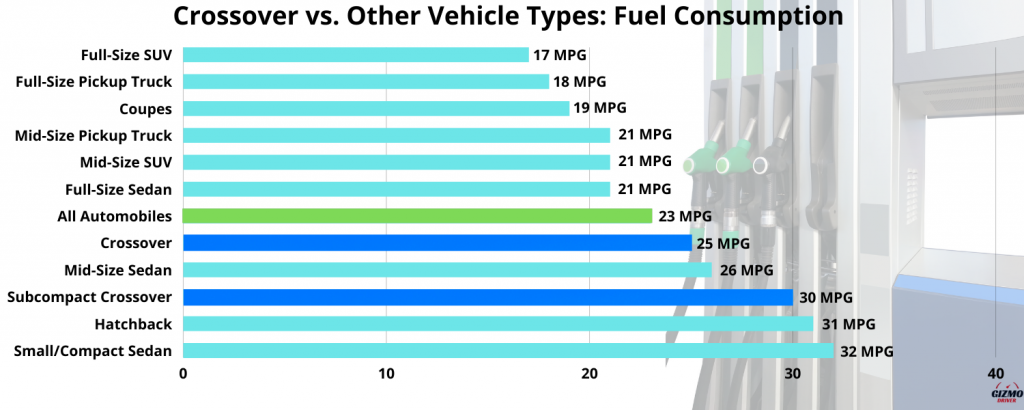
Crossover SUVs are among the more fuel-efficient types of cars. The average MPG for a crossover is 13% higher than the average for all cars.
Crossovers (Compact SUVs) vs. Mid-size SUVs
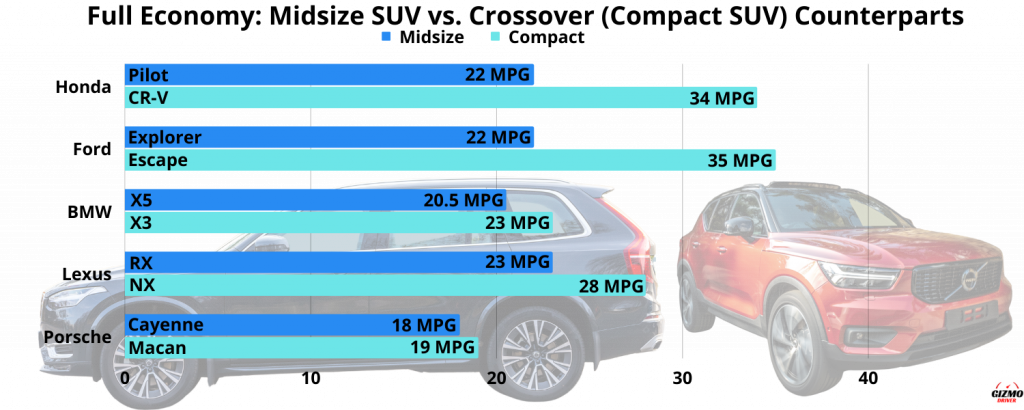
Crossovers are 32% more fuel-efficient than larger SUVs. A compact/subcompact crossover gets 32.8 miles per gallon on average, whereas a large SUV gets 24.9 miles per gallon on average.
Compact crossover SUVs get 5-10 MPG greater than their mid-size SUV counterparts from the same manufacturer. The difference in fuel economy is primarily due to weight, despite sharing many of the same platforms.
See our article about the average MPG for SUVs here.
Crossovers (Compact SUVs) vs Sedans
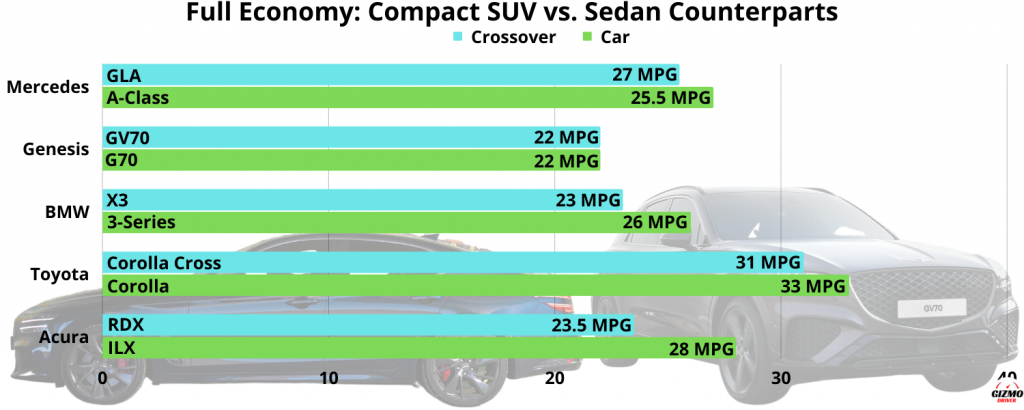
Crossovers are less fuel-efficient than sedans. A sedan gets 36.8 miles per gallon on average, while crossovers get 32.8 miles per gallon on average. The median sedan, on the other hand, only gets 1 MPG more than the median crossover (28 MPG and 27 MPG).
Sedans are typically 5% to 20% more fuel-efficient than their crossover equivalents within the same brand, while sharing many of the same platforms.
See our article about the average MPG for sedans here.

